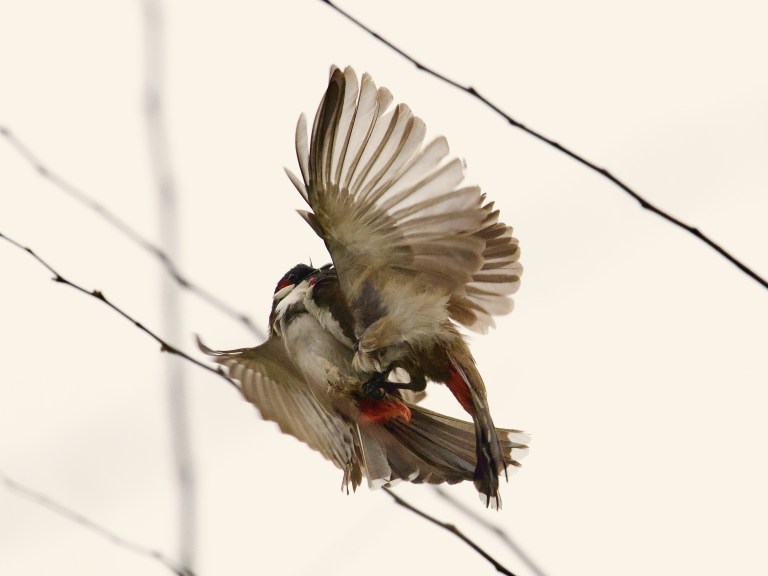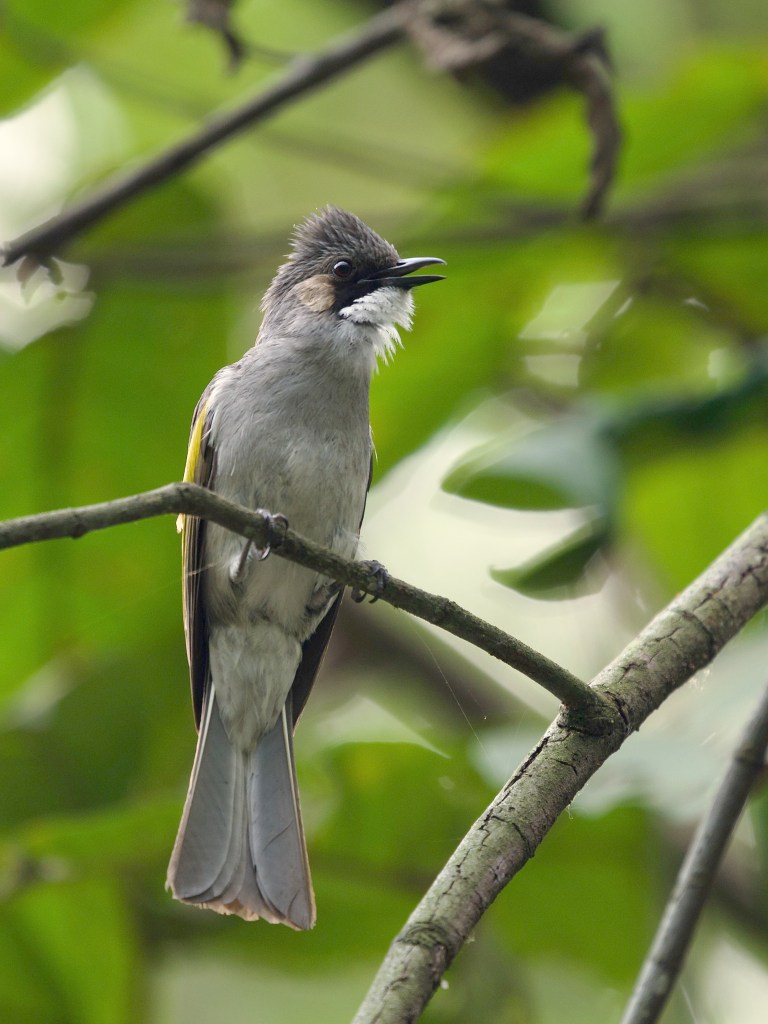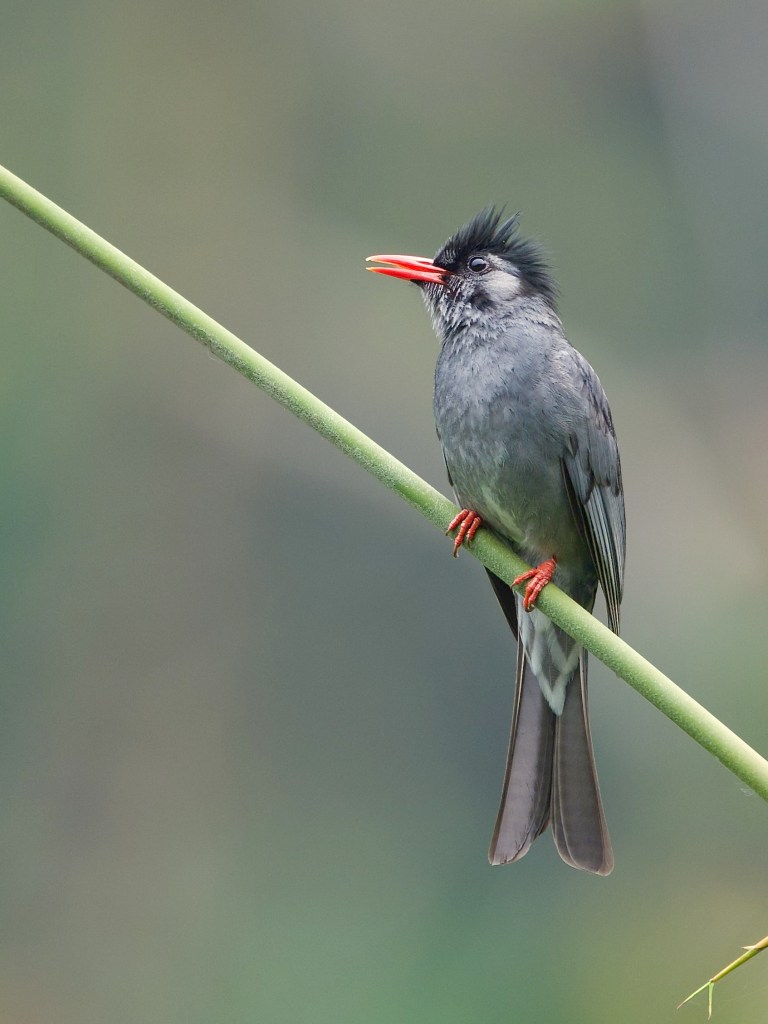Today we have part 3 of Ephraim Heller’s photographic journey to Bhutan (part 1 is here and part 2 here). Ephraim’s notes and IDs are indented, and you can enlarge his photos by clicking on them.
Here is installment #3 of photos from my April 2024 birding tour of Bhutan. We begin with photos of the interior courtyard of the Paro dzong.
And today I’ll post my photos of bulbuls, a babbler, and a fantail in Bhutan.
The bulbuls are members of a family, Pycnonotidae, of medium-sized passerine songbirds. The family is distributed across most of Africa and into the Middle East, tropical Asia to Indonesia, and north as far as Japan. There are 166 species in 32 genera.
The Red-vented bulbul (Pycnonotus cafer) is a resident breeder across the Indian subcontinent, including Sri Lanka extending east to Burma and parts of Bhutan and Nepal. It has been introduced in many other parts of the world and has established itself in New Zealand, Argentina, Tonga and Fiji, as well as parts of Samoa, Australia, USA and Cook Islands. It is included in the list of the world’s 100 worst invasive alien species. They are considered as pests because of their habit of damaging fruit crops.
In 19th-century India these birds were frequently kept as cage pets and for fighting especially in the Carnatic region. They would be held on the finger with a thread attached and when they fought they would seize the red feathers of the opponents:
Indians frequently tame it and carry it about the bazaars, tied with a string to the finger or to a little crutched perch, which is often made of precious metals or jade; while there are few Europeans who do not recollect Eha’s immortal phrase anent the red patch in the seat of its trousers.
— Hugh Whistler
Red-vented bulbul in flight:
The Red-whiskered bulbul (Pycnonotus jocosus) is a resident frugivore found mainly in tropical Asia. It has been introduced in many tropical areas of the world where populations have established themselves. It has a loud three or four note call, feeds on fruits and small insects and perches conspicuously on trees. It is common in hill forests and urban gardens. It has established itself in Australia and in Los Angeles, Hawaii, and Florida in the United States, as well as in Mauritius and Mascarene Islands. In Florida, it is only found in a small area, and its population could be extirpated easily. It was eradicated from Assumption Island in 2013–2015 to prevent colonization of nearby Aldabra, the largest introduced bird-free tropical island.
This species was once a popular cage bird in parts of India. C. W. Smith noted that “These birds are in great request among the natives, being of a fearless disposition, and easily reclaimed. They are taught to sit on the hand, and numbers may thus be seen in any Indian bazaar.” The species continues to be a popular cagebird in parts of Southeast Asia.
Red-whiskered bulbuls disagreeing about territory:
The Mountain bulbul (Ixos mcclellandii) is named after British East India Company Surgeon John McClelland. Its natural habitat is broadleaved evergreen forests between 800m and 2590m:
The Ashy bulbul (Hemixos flavala):
The Black bulbul (Hypsipetes leucocephalus) is found primarily in the Himalayas. Although males and females are indistinguishable to the human eye, there are significant differences in the ultraviolet reflectivity of the plumage making them readily distinguishable to the bulbuls themselves:
The White-hooded babbler (Gampsorhynchus rufulus) is a species of bird in the family Pellorneidae. It is found from the eastern Himalayas to central Myanmar and southwestern China. Its natural habitats are subtropical or tropical moist lowland forest and subtropical or tropical moist montane forest:
The White-throated fantail (Rhipidura albicollis). Birds use the same song year after year, with progressively small changes, with the result that the song sounds very different after 4–5 years:
Equipment: All animal photos were shot using a Nikon Z9 camera and Nikkor Z 400mm f/2.8 TC VR S lens. Landscape and architectural photos were shot either with a Nikon Z9 and Nikkor Z 70-200mm f/2.8 VR S lens or with an iPhone 11.
You can see more of my photographs at my Instagram site.














Lovely shots. Thank you.
This is such a set – I’m not sure an adjective – sort of simple, plain, small, but stunning beauty…
I’m listening to a Chopin mazurka also, so… Op. 59 no. 3, F# minor…
Beauties. I really like the babblers – the one on the right looks baffled. Thanks for the excellent photos
Interesting pictures!
Lovely birds, and I have to thank you for bringing Hugh Whistler and Eha to my attention.
“Pretty bird” comes to mind for the Red-whiskered bulbul, while the Red-vented bulbul appears to be in temporary free-fall. (I do wonder what birds would do in zero gravity, or in different levels of gravity.)
The Red-vented bulbul looks like he’s just pushed off the wall of a pool and is free floating underwater. Makes me want to go swimming!
Interesting looking birds. Especially the puffy-headed white one. I’ve enjoyed this series. Thank you.